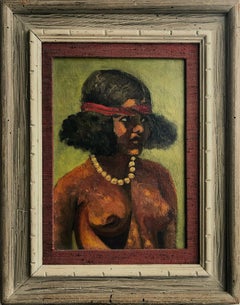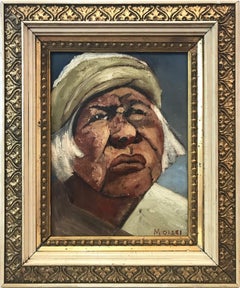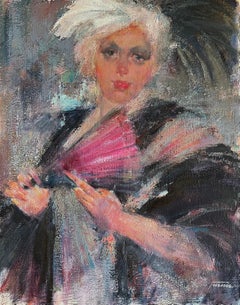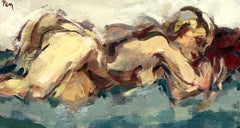Julio Moisés Fernández de Villasante Art
to
1
1
Overall Width
to
Overall Height
to
2
1
2
2
2
2
2
1
2
2
2
2
2
7,820
5,167
2,504
1,501
2
2
Artist: Julio Moisés Fernández de Villasante
"Modernist Female Nude with Pearls" Mid-20th Century Oil Painting on Canvas
By Julio Moisés Fernández de Villasante
Located in New York, NY
A strong modernist oil painting depicted in the 1940's by Spanish painter Julio Moises. Mostly known for his abstract figures on canvas, this piece is a w...
Category
Mid-20th Century Modern Julio Moisés Fernández de Villasante Art
Materials
Canvas, Oil
"Modernist Portrait" Mid-20th Century Spanish Oil Painting on Canvas Framed
By Julio Moisés Fernández de Villasante
Located in New York, NY
A strong modernist oil painting depicted in the 1940's by Spanish painter Julio Moises. Mostly known for his abstract figures on canvas, this piece is a w...
Category
1940s Modern Julio Moisés Fernández de Villasante Art
Materials
Canvas, Oil
Related Items
LADY WITH PICK FAN
Located in Los Angeles, CA
Biography from the niece of the artist from during his lifetime. Paintings acquired from the artist.s estate.
Max Turner
1925 - 2019
Max Lamar Turner Painter, Sculptor, Teacher and Author.
Max Turner was born in Omaha, Nebraska on July 28, 1925. His father was Lance Howard Turner and his mother Mary Irene Turner. In 1927, his family moved to Bingham Canyon, Utah where Max's father extracted copper from a creek that he had diverted to pass through his garage. The town was located in a narrow canyon on the eastern face of the Oquirrh Mountains. In 1938, when Max was 13, his family moved to Midvale, Utah. After completing high school, Max went to work laying rail until he was inducted into the U.S. Navy to serve during W.W. II.
There he took an aptitude test and was initially assigned to the medical corp., later transferring to the dental unit. Max was stationed at Port Hueneme, Ventura County, California through the end of the war. When he was discharged in 1946, he remained in Southern California, living in the Los Angeles area. He met a man named Larry Torres and they formed a partnership to do silk screen work primarily for the Colby Poster Printing Company. This lasted about 10 years until the Colby building caught fire and burned down. In 1958, Max began working for Slade Novelty company that made doll parts using a product called plastisol. A year later, Max began producing plastic parts through his own business. One day, a couple of kids brought in a shrunken skull they had made and asked Max if he could reproduce it. Max said he could and he looked around for a business to work with for this task. He ultimately decided he could create his own machine shop to make molds. As a result, Max purchased a lathe, drill press, grinder and other tools to create his own machine shop and went into business making molds. He built a clientele and in 1973, he moved his machine shop to Glendale, California.
Painter, Sculptor, Teacher and Author:
Max recalls the day when his interest in art took a new direction. He happened to be in a paint store to purchase some supplies when he saw a card posted on a wall that read, "Come paint with Connie Marlo". Max had been interested in art since his youth and he was frequently impressed with paintings displayed by local artists at various community events.
Consequently, he decided to go to Connie's Saturday morning art class at a studio on North La Brea Avenue (between Sunset and Hollywood) in Los Angeles. But, as fate would have it, he immediately took a detour from this class when he found a piece of paper on the floor of the studio referencing another art class dealing with compositions, patterns, rhythms and color harmony. The instructor's name was Hal Reed, a former art student of the Russian/American Master, Nicolai Fechin. Hal owned the building (previously the Will Foster Studio) and had founded the Art League of Los Angeles. When Max found Hal, he asked Hal if he could join his class. Hal said "No, the class was full" but he said Max could monitor the class in the back of the classroom. Max took him up on the offer and began observing the weekly class.
During the class, Hal told his students that they should practice what they were learning by going to "live model" classes. Max began attending these classes where he learned how to draw figures. After a few months, Hal and Max became good friends. Hal was so impressed with Max's work that he offered Max the opportunity to teach at another location that Hal was opening in the San Fernando Valley. Max accepted the offer and began teaching his own art class. For Max, it was a quick jump from learning to teaching. Max then found that several of his students had to commute to his art class from the west end of the "Valley". To better serve this group of students, Max decided to relocate to another studio in Calabasas.
Max continued teaching, and at this time he was producing very impressive portraits, both oil paintings and charcoal drawings from live models (Max never worked from photos). Max demonstrated real talent, and the style of his drawings and paintings were being compared to those of Nicolai Fechin. And, like Fechin, Max also had an interest in sculpting. One day, Max decided to design and cast a bronze owl sculpture to put in his Calabasas Fine Art Gallery. Later, someone approached Max when he was at the foundry and asked him about his success selling the owl sculpture. The individual who asked this question was convinced that there was a broader market for these sculptures and he ordered a dozen of the owl sculptures from Max. This encouraged Max to do more castings. Some of the new castings were antique sculptures he found and reproduced. As this new business grew, he decided to establish his own foundry, employing up to 15 workers. The business continued for many years, up until the late 1990's when Max got tired of the foundry business and sold it.
Max, who was now in his 70's, decided to move on to his next venture as an artist, dedicating himself to doing the actual sculpting of original art. He loved the creativity of sculpting and he had his sculptures cast at local foundries, ironically the same ones that used to be his competition. Max was now fully engaged in his new artistic direction and, over time, he produced a large body of work. He created very impressive sculptures, including about 100 full-size sculptures. He sold some of these to high-end clientele, the Foundry at SLS Las Vegas, and to Hollywood studios.
Even though Max now seemed to be totally in his element, he somehow also found time to continue to teach painting classes at the California Art Institute in Westlake Village in Los Angeles. At the institute, he specialized in figure work. Max continued to draw, paint and teach, but he says he stopped sculpting when he turned 90.
Max produced four books showcasing his drawings and paintings. The first is "Faces, The Drawings of Max Turner", copyright 2000, that showcases nearly 100 of his portrait drawings. Within the "Acknowledgements" section, he lists Hal Reed and Joseph Nordmann, two former students of Nicolai Fechin.
In 2006, Max produced his second book titled "Figures and Faces", reflecting not only portraits but also figure drawings and paintings. It is a wonderful book of Max's work, but it is currently difficult to find. The third book is titled "Faces 2, The Paintings and Drawings of Max Turner", copyright 2009, which includes 75 portrait paintings and drawings. In the "Preface" of this book, Max describes growing up in a small and isolated mining town during the Great Depression. He states that as a kid, he had little exposure of any culture or view of what the rest of the world was like. His neighbor was the trash collector and Max would sometimes go through his truck looking for anything of value. Among other things, he found magazines like Cosmopolitan, Good Housekeeping and Red Book, with covers that frequently showed drawings or paintings of faces. Max states that these images were the very first source of inspiration for him. He says that he began looking more carefully at people's faces and if they had character, he would draw them. By drawing them, Max says that he was making them part of his world, his world of "Faces".
In 2018, Max published his newest book showcasing his drawings and paintings. It is titled "Max Turner's Figure Sketches". This softbound book includes 76 pages and over 120 drawings and paintings. In the Introduction, Max explains "I have found that when approaching the figure, one should begin with the gesture. After having captured the essence or feeling of the pose, one can then proceed to build on it." The figure sketches in this wonderful book reflect a Master's work that consistently captures the "gesture"-showing the emotion, movement and expression.
Two more books are on the horizon for Max, both dealing with his passion for sculpting. His first, "The Sculpture of Max Turner" is a compilation of his commercial and noncommercial pieces throughout his career. The second, "Terra Cotta Sculpture by Max Turner" is a complete collection of figures done at the California Art Institute. These much anticipated books should be out later in 2018.
Max now considers himself primarily a sculptor. But others in the art world are more than impressed with his drawings and paintings as well. His portraits are often described as having a Fechin-esque appearance, referring to the style of Nicolai Fechin. When Max observed those first art classes given by Hal Reed, it should be noted that Hal had previously been a student of the Russian/American Master Nicolai Fechin in the early to mid-1950's. In fact, Hal was a student in the last art class that Fechin taught before he unexpectedly died in 1955. Hal was so strongly influenced by Fechin that he later produced two 30-minute art instruction videos as part his Art Video Productions wherein he specifically described Fechin techniques that he learned in Fechin's class. The Fechin style and techniques were in play when Max later met Hal. Over the years, many of Max's art students, art collectors, gallery owners, as well as the Director of the Monterey Museum of Art have commented on the Fechin-esque qualities of Max's wonderful charcoal drawings and paintings. So, while Max may consider himself primarily a sculptor, his drawings and paintings are also impressive and very much sought after.
When Nicolai Fechin died in 1955, three of the nine students in his last art class became life-long friends. Max subsequently became friends with not only Hal Reed, but also with prior Fechin students Joseph Nordmann and Albert Londraville...
Category
1990s Modern Julio Moisés Fernández de Villasante Art
Materials
Canvas, Oil
A Fabulous, Abstract 1960s Mid-Century Modern Painting of a Sleeping Female Nude
Located in Chicago, IL
A Fabulous, Abstract 1960s Mid-Century Modern Painting of a Sleeping Female Nude by Noted Chicago Artist, Rudolph Pen. A sensuous, intimate studio depiction of a sleeping nude femal...
Category
Mid-20th Century American Modern Julio Moisés Fernández de Villasante Art
Materials
Canvas, Oil
H 14.75 in W 26.75 in D 2 in
Modern Reclining Nude Study of Red Haired Woman
By Patricia Gren Hayes
Located in Soquel, CA
Modern nude study of red-haired woman reclining seated by American painter, Patricia Gren Hayes (b. 1932), 1979.
Signed and dated on verso
Provenance: Purchased as part of larger collection of artist's work
Unframed.
Canvas size: 16"H x 20"W.
Patricia Gren Hayes (American, b. 1932) is a Bay Area Figurative & Feminist Art Movement artist who studied at Winnipeg Public Art School in 1950. She received early recognition in Museum and Gallery competitions and exhibitions and was awarded a Special Education in Art recognition by the Winnipeg Museum of Fine Art, and was awarded a scholarship to the Banff College of Fine Art. Further studies were at The University of Manitoba.
She was a Member of Winnipeg Free Press Sketch Club and was a Cartoonist and paste-up for a French-English bi-weekly, in Eastern Canada;
She studied outdoor impressionism in New York in 1960; in 1962, attended The California College of Arts and Crafts, and in 1976 B.A., U.C. Berkeley where she studied under Elmer Bischoff, David Simpson, Joan Brown, Felix Ruvolo, Yolanda Lopez and Vincent Perez.
She started a freelance commercial art business in 1963; copyrighted a National Cartoon, 1976, and served as Exhibition Director for San Francisco Woman Artists Gallery and the San Francisco Museum of Modern Art, 1976-1978. She was a workshop instructor at the San Francisco Woman Artists Gallery, 1977-1985; and was Manager/Owner Stanton Art Gallery, Alameda, CA, 1976-1982.
Solo Exhibitions:
Berkeley Marina, 1974;
Oakland Center for The Visual Arts, "Images of Women", 1979
Group Exhibitions:
Oakland's Dept of Education, 1963, Studio One;
Alameda County Fair, 1975, 1976, 1978;
San Francisco Art Festival, 1969, 1970, 1976, 1977, 1978;
San Francisco Museum of Modern Art, 1976, 1977, 1978;
San Francisco Women Artists Gallery Exhibition, award winner - 1970, 1977, 1978;
Hayward Bay Fair Art Festival, award winner - 1971;
Capricorn Assunder Gallery, 1973;
Oakland Art Festival, 1973, 1974;
Alameda Art Association, 1978;
El Cerrito...
Category
1970s American Modern Julio Moisés Fernández de Villasante Art
Materials
Canvas, Oil
Charles Kvapil, "On the edge of the lake", ca.1920
By Charles Kvapil
Located in Saint Amans des cots, FR
Oil on canvas by Charles Kvapil, France, ca.1920. "On the edge of the lake". with frame: 78x58.5x6 cm - 30.7x23x2.4 inches - without frame: 65x46 cm - 25.6x18.1 inches. 15M format. Signed lower left "Kvapil"
Charles Kvapil was born in Czechoslovakia on November 1, 1884, and died in Paris in 1957.
He takes courses at the Royal Academy of Fine Arts in Antwerp. His first works are exhibited in 1908, at the Salon of Antwerp. In 1911, he exhibits in Munich; his works show a definite cubist influence in a well-tempered, organization and simplification bill. Arrived at a young age in Paris, he sets up his studio in Montmartre in the Hamlet of Artists, between Lepic Street and No. 11 Junot Avenue near those of Utrillo and Valadon; it is there that he will die.
In 1912, he exhibits at the Salon des Independants. In 1914, he presents his works again in Belgium at the Brussels Triennal.
After the war, he lives a very poor life but, with an optimistic temperament, he hopes to break through; he has to work to survive and he paints especially in the evening, especially during his first years in Paris. It is at the Salon des Independants in 1920 that Kvapil is revealed to the Parisian public. He exhibits six paintings: "My campaign", "portrait of woman", "Houseboat", "Poplars", "Bras St. Jean (landscape)" and "Still Life". He is domiciled at 233, rue d'Alésia in Montparnasse."
"In the wake of the legendary figures of Montparnasse, in their shadow, and by them held at a relative discretion (the behavior of artists entering many into the brilliance of their career and the exclusive attachment to their production, without extension" social " " condemning them to darkness), is Charles Kvapil. He frequents the Parnassus café [...] and is exhibited there in a small group organized by A. Clergé, "the Company of professional painters and sculptors", which manifests itself in 1921. The preface is written by Romoff. A second follows shortly. It includes 102 participants, including Friesz, Lagar, Zorate Ortiz, Scouëzec, Astoy, Roysen, Loutreuil, Krémègne, Gallien, Goncharova, Lebedeff, Ramey, Kvapil. He remains attached to the folklore of the Bohemian painter whose Montparnasse is the field of exploits and the model of life "(Jean Jacques Lévêque" The Roaring Twenties, 1918-1939 - The Triumph of Modern Art ", 1992).
He exhibits at the gallery Colette Weill. In 1923, his works are hung at Marcel Bernheim, then at Dalpeyrat, in Limoges, where he shows mostly landscapes. Subsequently, he participates in the Salon d'Automne; to that of 1941, he presents "Phlox", and in 1944 "At the window". In 1951, at the same Salon, he exhibites "Plaisir d'été" and "Le Goûter".
He exhibits during his lifetime in Paris, Munich, Brussels, Geneva, Italy, Stockholm, London and New York.
He is now represented in numerous public and private collections, including the Museum of Modern Art in Paris, the museums of Le Havre, Libourne, Rouen, Saint-Etienne, Amsterdam and Tunis.
Charles Kvapil is known mainly as a painter of characters, especially for his representations of naked women for which his friend Ginette often served as a model; he painted models in the studio, sometimes in front of his window with the Montmartre hill in the background; often bathers or female nudes placed in groups of characters, in the manner of Courbet and the Impressionists at their beginning.
He is also creator of many portraits; but he did not disdain either the still lifes, especially the bouquets of flowers, or the landscapes, which form an important part of his work.
He painted many regions, including Corrèze, where he "knew how to grasp the character of the country that is not his, with his usual mastery" (SSHA Bulletin Corrèze), the Mediterranean coast, Corsica, where he stays regularly in the 1920s and 1930s; in Paris he participated in exhibitions of painters of Corsica in 1925 and 1933. In 1939, at a new exhibition of Art Corse, at the Gallery The Team, still in Paris, he presented two paintings titled "Costa Brugiata, Cap Corsica "and" View of Rogliano ". He is also the creator of "On the Island" (1923), "Querciolo, Rogliano" (1923), "Corsican Woman" (1924), "Landscape of Corsica" (1933) (information Cronica di a Corsica).
Charles Kvapil was influenced by fauvism and a very temperate cubism; Paul Cézanne and to a certain extent Matisse (as a colorist), also marked his style. The desire of construction of the artists of the group to which Kvapil belongs, "did not lead to distortion, except once or twice at Kvapil" .... Kvapil and his friends "thus engaged in thorough technical studies according to the masters, all without exception have loved the beautiful solid and dense material. Their work is related, moreover, not to the classical tradition of transparent painting, but to that of the opaque painting of Frans Hals, Rembrandt and Chardin, almost alone in force since the beginning of the nineteenth century [...] so they paint all in dense pasta but without excessive excess "... (Germain Bazin," the love of art ", 1934).
Charles Kvapil's paintings are original and modern, his nudes and bouquets of flowers are strong and powerful. His palette is rich in cobalt blue and warm colors. His technique is voluntary and powerful. His works in oil are often of modest size, sometimes painted on panels, or on cardboard. He also practiced with great skill the technique of pastel. P. Béran, in a study he has dedicated to him, praises the richness of his material and all that his art owes to the joy of living.
"A work modeled on a life totally devoted to the pleasure of painting. (Jean Jacques Lévêque, ibid.)
He was an indefatigable worker, and this is what he says: "the painter must speak little, but he must comb a lot"
Bibliography
Jean-Daniel Maublanc, Charles Kvapil, painter of figures, 72 p.
Jean-Daniel Maublanc (preface by Louis Parrot), Perspectives - Marcel Lemar, François Eberl, Marcel Roche, Jacques Villon, Charles Kvapil, Charles Jacquemot, Pierre Bach...
Category
1920s Modern Julio Moisés Fernández de Villasante Art
Materials
Canvas, Oil
H 23.04 in W 30.71 in D 2.37 in
A Dynamic Abstract, 1950s Mid-Century Modern Standing Female Nude in an Interior
Located in Chicago, IL
A Large, Dynamic, 1950s Mid-Century Modern Painting of an Abstract, Standing Young Female Nude in a Studio Interior by Noted Chicago, Artist Rudolph Pen. Artwork size: 40” x 13”; ...
Category
Mid-20th Century American Modern Julio Moisés Fernández de Villasante Art
Materials
Canvas, Oil
H 40.5 in W 13.5 in D 2 in
Ballerina - Oil Paint by Miroslava Vrbová-Štefková - mid-20th Century
Located in Roma, IT
Dancer is a beautiful oil on panel realized by Vrbová-Štefková in the mid-20th Century.
Signed and framed, 60 x 50 cm.
Good condition.
Category
Mid-20th Century Modern Julio Moisés Fernández de Villasante Art
Materials
Canvas, Oil
H 23.63 in W 19.69 in D 1.97 in
Vintage Mid-Century Modern Original Figurative Oil Painting -The Expectant Nude
Located in Bristol, GB
THE EXPECTANT NUDE
Size: 55.5 x 70.5cm (including frame)
Oil on canvas
A brilliantly executed and emotive mid-century modernist figurative portrait of a reclining pregnant nude...
Category
Mid-20th Century Modern Julio Moisés Fernández de Villasante Art
Materials
Oil, Canvas
'Sheila Antoine with Afro', Sir John Cass, Otis Art Institute, California
By Pearl Took
Located in Santa Cruz, CA
Signed lower left with monogram, 'P.T.' for Pearl Took (American, 1928-2012); additionally signed verso, dated 1977 and titled 'Sheila Antoine'.
Born in England, Pearl Took first st...
Category
1970s Modern Julio Moisés Fernández de Villasante Art
Materials
Canvas, Oil
H 24 in W 20 in D 0.75 in
A Distinctive Mid-Century Modern Portrait of a Man with Red Necktie, Joe Muldoon
By Francis Chapin
Located in Chicago, IL
A distinctive Mid-Century Modern portrait of a man with red necktie by noted Chicago painter, Francis Chapin (Am. 1899-1965). Chapin's estate records list the sitter as named Joe Mu...
Category
Mid-20th Century American Modern Julio Moisés Fernández de Villasante Art
Materials
Canvas, Oil
Mid Century Sitting Nude Figurative
By Elmer Albritton
Located in Soquel, CA
Mid Century figurative painting of a pensive sitting nude figure with moody, mid-century color palette in the background. Attributed to Elmer S. Albritton, unsigned (American, 1922-...
Category
1960s American Modern Julio Moisés Fernández de Villasante Art
Materials
Canvas, Oil, Cardboard
'Double Figural', California, Post Impressionist Oil, Santa Monica College
Located in Santa Cruz, CA
Signed lower right, 'Goetz' for Jack Goetz (American, born 1919).
Jack Goetz has painted and exhibited with success for many years and continues to paint at the age of 104.
Speaki...
Category
1990s Modern Julio Moisés Fernández de Villasante Art
Materials
Canvas, Oil
H 24 in W 18 in D 0.75 in
PASSION #1 - Nude Male painting Paula Craioveanu oil on canvas
By Paula Craioveanu
Located in Forest Hills, NY
"Passion #1" - An original signed oil painting on canvas by artist Paula Craioveanu - titled "Passion #1".
Hand painted and hand signed by artist upper right. It is also signed, ti...
Category
2010s Modern Julio Moisés Fernández de Villasante Art
Materials
Canvas, Oil
H 35.5 in W 23.5 in D 1 in
Julio Moisés Fernández De Villasante art for sale on 1stDibs.
Find a wide variety of authentic Julio Moisés Fernández de Villasante art available for sale on 1stDibs. You can also browse by medium to find art by Julio Moisés Fernández de Villasante in canvas, fabric, oil paint and more. Much of the original work by this artist or collective was created during the 20th century and is mostly associated with the modern style. Not every interior allows for large Julio Moisés Fernández de Villasante art, so small editions measuring 13 inches across are available. Customers who are interested in this artist might also find the work of Elisabeth Sabala, Jean Calogero, and Samuel Grunvald. Julio Moisés Fernández de Villasante art prices can differ depending upon medium, time period and other attributes. On 1stDibs, the price for these items starts at $1,900 and tops out at $2,500, while the average work can sell for $2,200.



